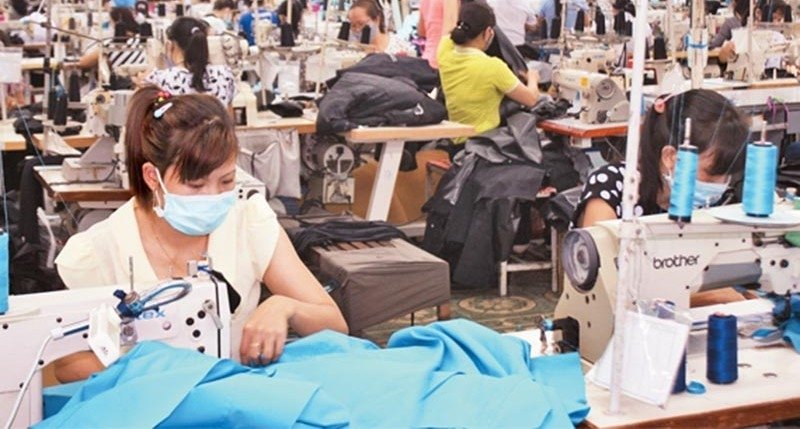
|
2021 was a very difficult year for Vietnam’s textile and garment industry, when it was heavily affected by the COVID-19 pandemic, leading to supply disruptions, closures of many enterprises, and event bankruptcy. Thanks to the flexibility in applying solutions to maintain production and promote exports, garment and textile enterprises have gradually overcome difficulties and achieved their set goals. |
|
The total export turnover of Vietnam’s textile and garment industry is estimated at 39 billion USD in 2021, up 11.2% compared to 2020 and up 0.3% compared to 2019. This is considered a great effort of Vietnam’s textile and garment industry, in the context that the recovery speed of the worlds’ economy tends to slow down and the result is also a premise to promote the industry’s development in the near future. Exceeding the set target According to Chairman of the Board of Directors of Hung Yen Garment Corporation (Hugaco) Nguyen Xuan Duong, Vietnam’s textile and garment industry has faced many challenges over the past two years, when many garment factories had to close or cut output. In addition, during the social distancing period, labour productivity did not reach goals, while more costs were incurred to maintain the “3-on-the-spot” production model. By implementing several solutions to boost production, the total revenue of Hugaco reached 134.5 million USD in 2021, up 17% over 2020, while the export turnover reached 350 million USD, up 20% compared to 2020. The corporation also has orders to fulfil until May 2022. It also continues to invest in equipment and digital transformation, to increase productivity and processing prices, thereby raising the average income for employees by about 7% per year. Duong noted that the garment and textile industry is a labour-intensive industry, so it is difficult to avoid COVID-19 infection from the community. Thus, the State should quickly provide housing support for employees by providing land or assisting enterprises in building apartments for workers. Deputy General Director of Garment 10 Corporation Bach Thang Long said that, in addition to the urgent need for worker’s housing, policies to support businesses during the pandemic also play a prerequisite role. The State and Government need to study and issue many financial support packages and other policies, such as tax and fee reduction to create conditions for enterprises to invest in and boost production. Despite negative impacts of the pandemic, May 10 flexibly applied measures to maintain production, thereby helping the corporation’s total revenue in 2021 increase by 5% compared to 2020. According to General Director of Vietnam National Textile and Garment Group (Vinatex) Cao Huu Hieu, the goal in 2021 of Vinatex members was to reduce order losses, retain and stabilise employees’ psychology. Member enterprises will work closely with customers to jointly come up with solutions to avoid loss of orders and soon complete the set targets. The total profit of Vinatex is estimated to reach 1.2 trillion VND in 2021, an increase of 70% compared to the plan and a double increase compared to 2020, while the total revenue is expected to reach 16.44 trillion VND, up 10% compared to 2020. Speeding up the export of goods Statistics from the Vietnam Textile and Apparel Association (VITAS) show that the total export turnover of the textile and garment industry is estimated at 39 billion USD in 2021, up 11.2% compared to 2020. Vietnam’s main export markets, such as the US, the EU, the Republic of Korea and China, all posted export increases compared to 2020. The pandemic situation is predicted to be complicated throughout the world and Vietnam in 2022, requiring businesses to both deploy effective solutions to prevent the pandemic, while promoting the production. The world consumer demand is forecast to increase again in 2022, which will be an ideal condition for businesses to accelerate the export of goods. According to VITAS, if the pandemic is controlled in the first quarter of 2022, the export turnover of the industry can reach 42.5-43.5 billion USD, while if the pandemic is controlled in the middle of the year, the export turnover will be 40-41 billion USD and if the pandemic is controlled by the end of the year, the export turnover will reach 38-39 billion USD. To accomplish the aforementioned goals, enterprises must ensure jobs for employees through fulfilling orders. Pandemic prevention and control play a very important role in production, because only when the pandemic is controlled, enterprises can stabilise production. To maintain a stable workforce, businesses also need to have solutions to take care and retain employees, so that they are ready to stick with the business for a long period of time. In addition, the State should have mechanisms and policies to support business development. Vinatex General Director Cao Huu Hieu said that the prices of input materials such as cotton, fibre, yarn and fabric, continue to advance, while logistics prices are still increasing, which will be a big challenge for garment and textile enterprises in the coming times. Although a good recovery of market demand brings opportunities for businesses, inflation is also a matter that businesses need to pay attention to. Vinatex is building strategies and providing market solutions to help its member enterprises boost exports in the future. In addition, Vinatex also expects the State to have special support policies for the textile and garment industry, regarding supporting industries, investment attraction, export promotion funds, financial support, and others to help raise the competitiveness of businesses. Enterprises in the industry are also encouraged to innovate technology, increase the rate of technology applications in production, and improve productivity, quality, and working conditions towards smart and sustainable production, Hieu noted. Source: Nhan Dan Online |
